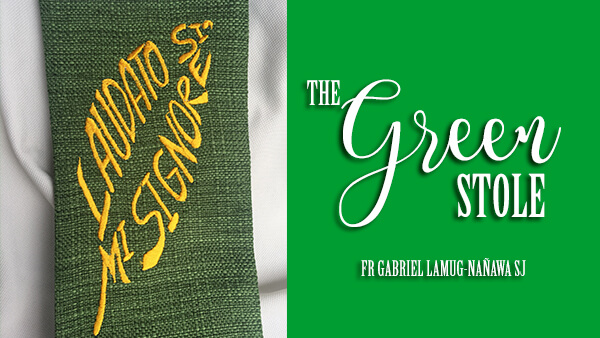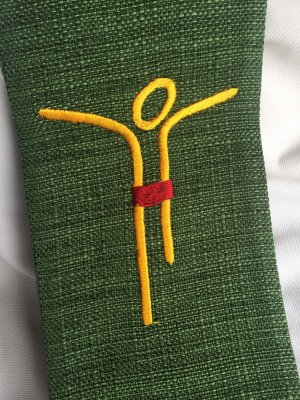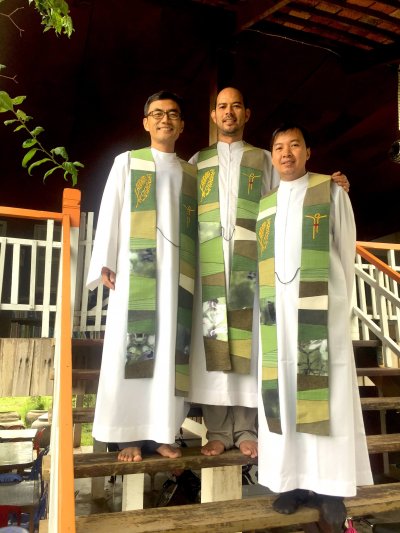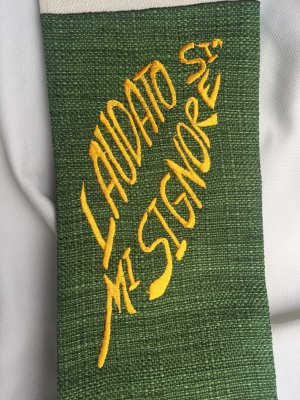


Fr. Gabriel Lamug-Nañawa SJ
June 30, 2017
For many centuries, the priest’s stole has played a constant role during the administration of the sacraments and in liturgical celebrations. Although not essential for the validity of the Holy Eucharist, the mass stole is an important part of the liturgical vestment worn by those who have received Holy Orders, a specific mark of their office as God’s ordained servants. At the same time, the stole also helps the congregation focus on the theme of the celebration by displaying the appropriate liturgical color as well as religious symbols that help guide our attention and prayer.
Thus, on the occasion of the 2nd anniversary this June 18 of the proclamation of Pope Francis’ encyclical, Laudato Si’, we have designed and put together a green stole for priests to be worn during ordinary time. Meant to continue the integration of the spirit and teachings of Laudato Si’ into the celebration of the sacraments, especially the Eucharist, we hope that this new stole will be helpful in guiding us all in praying and caring for creation, our common home.
There are three features to the Laudato Si’ Stole. The first and most visible aspect is the coming together of several colors forming the whole length of the stole. There are a total of eight different clothes, mostly different shades of green with varying textures, cut into small pieces that are sewn together, giving an earthy feeling or a refreshing sense of nature. These different shades and textures symbolize the different elements of nature, highlighting the great richness and diversity of plant and animal species, habitats, peoples, cultures, all intimately integrated, united in a single unbroken chain. With each piece of cloth being cut by hand, each stole is unique and different from one another, as the different cloths can differ in size, shape, and sequence.
A second feature is the crucifix from Cambodia. Long regarded as capturing and symbolizing Christ’s compassion and identification with victims of war, persons who have lost limbs and their sense of dignity and hope, this crucifix provides consolation with the assurance that Jesus accompanies and labors with them. But creation itself is also now marginalized and counted among the poor. And through this same crucifix, Christ labors and groans with creation that is violated, with creatures that are poached and driven to extinction, with indigenous peoples who have lost lands and livelihoods, becoming environmental refugees. Christ’s body bears the pain and the injustice that we ourselves are wreaking upon creation.
Finally, the words “Laudato Si’ Mi Signore” praise God our Lord, our creator and redeemer. The text is shaped like a fish or a leaf, depending on the viewer’s interpretation. Besides reminding us of the spirit of Pope Francis’ encyclical, it also tells us that our approach to creation does not begin with trying to solve its many problems. Rather, we are first thankful for all creation, turning to God with praise and gratitude for everything that exists, for existence itself, for God’s laboring that makes all creatures beautiful and fruitful.
We hope that this stole will inspire greater awareness, empathy, love, and responsible action towards God’s creation.
The Laudato Si’ Stole was designed by 4 people: Ms Techie Mendoza, a guidance counselor from the University of the Philippines; Ms Tess Rapadas, former teacher of Miriam College, mentor to many, and environmental advocate; Fr Joey Rapadas, Vicar General of the Diocese of Ipil, Philippines; and Fr Gabriel Lamug-Nañawa SJ, Jesuit missionary in Cambodia. The stoles were put together by Talleres de Nazareth, Quezon City, Philippines, for Jesuit Mission Cambodia.
Dom on July 26, 2017 AT 10 pm
Thanks for this beautiful story about the green stole. Amazed by the art, craft, story and purpose of Laudato Si that is weaved/sewn into the stole ☺️
Michael Gill on June 6, 2018 AT 12 am
How can I purchase a green stole?
What is the price and how best to pay?
Gift for a friends ordination in North Sydney this month
Comments are closed.